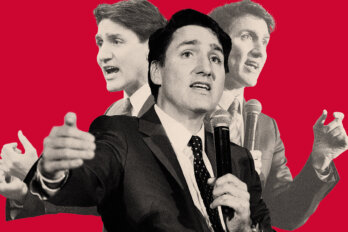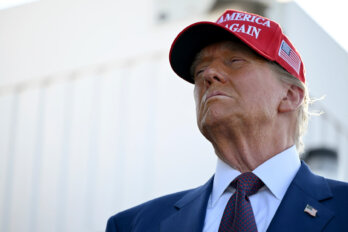Last Tuesday’s US presidential election was a lot of things: surprising for some, terrifying for others, and the sweetest vindication imaginable for a small group of people who don’t appear to deserve it. But one thing that nobody expected it would be? A boon for proponents of electoral reform in Canada. The fact that Hillary Clinton lost the electoral college to Donald Trump despite winning the popular vote provided the best illustration yet of the dangers of a winner-take-all system. It also gave us a more compelling reason for why reform is needed: not just to maximize the fairness of our democratic process, but to enshrine the value of diversity in our politics.
Trump’s win ought to change the calculus guiding the Liberal government’s halting attempts to fulfill its campaign promise to put an end to Canada’s first-past-the-post electoral method. The Special Committee on Electoral Reform that the government struck earlier this year—one that, to its credit, it didn’t stack with government MPs—has spent the summer consulting with Canadians, and is due to report its findings by December 1. Those findings will represent the distillation of the 550 briefs submitted to the committee, the 729 witnesses that appeared before it, and the 23,000 people who filled out an online questionnaire. The government has reportedly decided to augment those findings with a postcard that will be mailed to 13 million households encouraging them to share their views online by December 31. The Liberals will then synthesize this new information, weigh it against the committee’s work and its own political interests, and bring forward the legislation it promised to deliver within eighteen months of forming government.
The matter of electoral reform has been simmering for the better part of a decade, and there have been five referenda on the issue at the provincial level—two in BC, two in Prince Edward Island, and one in Ontario. Canada’s winner-take-all electoral system hasn’t elected anyone quite like Donald Trump, but it has consistently rewarded parties who receive a plurality of the vote with a majority of the seats—and, as a result, all of the power. In our most recent federal election, Justin Trudeau’s Liberals earned 39.5 percent of the popular vote, but won 54.4 percent of the seats and therefore 100 percent of the political power. Indeed, it’s been more than 30 years since a party actually won a true majority in a federal election, when Brian Mulroney’s Progressive Conservatives picked up 50 percent of the vote and 75 percent of the seats in its 1984 defenestration of John Turner’s Liberals.
Perhaps the most egregious example of first past the post’s flaws came in the 1993 election, when those same Progressive Conservatives were nearly wiped off the electoral map. Yes, they were reduced to just two seats, with a paltry 16 percent of the popular vote. But the Bloc Quebecois, despite earning just 13.5 percent of the popular vote, ended up with 54 seats due to the geographic concentration of its support. As the National Post’s Andrew Coyne wrote back in 2005, when British Columbia was considering a change to its own first-past-the-post system, “the party that can cluster its votes geographically will win many more seats than a party whose support is spread more broadly and evenly, rewarding regional grievance-mongering at the expense of a national vision.”
This isn’t first past the post’s only flaw. In recent years, its impact on the political aspirations of women and minorities has attracted more attention. And no wonder: in countries that use the system, the proportion of women elected to public office remains stubbornly low. In the United Kingdom, for instance, the 2015 election produced a House of Commons in which 29 percent of its members were female—a pitiful showing, but an improvement on the 22 percent figure from the previous election. In Canada, the 2015 election matched that sorry figure, with just 88 female MPs elected out of 338 in total. And in the US, the 114th Congress saw 105 women elected to the 435 member House of Representatives.
Australia’s Commonwealth Parliament has an equally deplorable record, but it’s the most interesting case in the bunch. That’s because while its lower chamber elects members using a winner-take-all system, its upper house does so using a proportional system. Everything else remains the same, from the electorate to the timing of the election, which makes it a nearly ideal petri dish in which to study the impact that an electoral system can have on political representation. And guess what? The Australian Senate consistently elects around 10 percent more women than the Australian House of Representatives, and its representation of them currently sits just a hair’s breadth shy of 40 percent.
Proportional systems can also have salutary effects on the political representation of other minority groups. In New Zealand the implementation of a mixed-member proportional system in 1994 (one in which citizens vote twice: once for a single-member electorate, and once for a party) has lead to a notable increase in the election of aboriginal candidates, over and above the designated electorates that are set aside for them under the country’s Māori Representation Act. “Of the eight political parties that contested New Zealand’s 2014 election, three of them had leaders of Māori heritage,” Devon Rowcliffe wrote in an August 2016 piece for The Tyee. “When was the last time that a federal Canadian political party with seats had a non-Caucasian leader?” Kelly Carmichael, the executive director of Fair Vote Canada, thinks the impact of proportional systems on political diversity is reason enough to give them serious consideration. “I think it’s time for us to put our money where our mouth is and bring in a system that truly represents who we profess to be,” she says.
There’s just one problem: Canadians don’t seem to care. According to an Ipsos poll from early September, only 19 percent of Canadians were aware that the government’s public consultations on electoral reform were already happening, while just 16 percent of those people—or roughly three percent of the population as a whole—said they were watching the matter closely. Witness the results of the recent plebiscite in Prince Edward Island, which saw just 36.5 percent of eligible voters bother to cast a ballot despite having more than a week in which to do so.
This indifference shouldn’t be surprising, according to the University of Waterloo political science professor Emmett Macfarlane. “You can poll on electoral reform, and you’ll get some interesting responses depending on the wording of the question. But is this on anyone’s list of top 20 priorities for government? No. There’s no evidence that there’s any grassroots agitation for electoral reform. This is almost entirely the purview of rather hardcore partisan politicians and academics.”
But why should Canadians care? Until last Tuesday, I would have counted myself among the indifferent. But electoral reform is no longer just about improving our democratic interactions. It’s also a way to inoculate our political institutions against the virus that Trump’s election has unleashed—a virus that’s already crossed the border to us.
In an email to supporters after Trump’s election, Conservative leadership candidate Kellie Leitch declared that his victory represented “an exciting message that needs to be delivered in Canada as well.” Meanwhile, in Alberta, Sandra Jansen, the leading female candidate in the race to elect the next leader of the province’s Progressive Conservative party, quit unexpectedly on Tuesday after weeks of online harassment culminated in a conspicuously hostile PC event in Red Deer over the weekend. “Volunteers from another campaign chased me up and down the hall, attacking me for protecting women’s reproductive rights, and my team was jeered for supporting children’s rights to a safe school environment,” she said in a statement. The only other female candidate in that race, Donna Kennedy-Glans, stepped aside the same day. So make no mistake: Trumpism has arrived.
That reality effectively diminishes a lot of the criticism against proportional systems. Yes, such systems can invite polarization by enabling the election of single-issue, single-constituency parties—and one need only look at the Knesset (Israel’s parliament) to see what that looks like. But Israel’s system is also an orthodox interpretation of proportional representation, and it’s not one that has ever been seriously considered in or for Canada. More to the point, we’re now living in a world where extremist politicians like Marine Le Pen and Trump are moving into the mainstream, and the consequences of that in a first-past-the-post system are far more dangerous. “First past the post doesn’t give you what voters say,” says Carmichael. “Hillary Clinton won the popular vote, and the system gave Americans Donald Trump.”
And what about the stability that first-past-the-post proponents often cite as a feature of the system? That, too, doesn’t look nearly as good in the current context. “We’re going to watch Donald Trump rip apart everything that Barack Obama has put in place,” Carmichael says. “That doesn’t happen with a proportional system. We watched the same thing happen here. The Liberals came in and they’re undoing what the Conservatives had done, and the Conservatives undid what the Liberals had done. It’s just incredibly ineffective policy making, and when you look at proportional countries you see continuity. There aren’t massive swings. You can vote people in and out, but a two percent difference in the vote doesn’t mean a wholesale change in government, which is what you see under winner-take-all politics.”
There’s not a lot of upside for Liberal government in implementating a proportional system when it has benefitted so consistently from the status quo. That’s the Catch-22 with electoral reform: if a party advocating on its behalf ends up in a position to actually do something about it, they almost certainly got there because of the system they supposedly want to change. And Prime Minister Trudeau has plenty of outs here if he wants to take them. If the committee produces a series of minority reports, as Macfarlane suspects will happen, the prime minister can point that and say, “Well, there’s no consensus. We tried.” He could also put the question to a referendum and attach a more demanding threshold for success, as governments did in BC in 2005, Ontario in 2007, and BC again in 2009. In each case, electoral reform was defeated.
That losing record might help explain why the Conservatives, who are most committed to the status quo, want to hold a national referendum this time around. And the NDP, which had been a vocal opponent of putting any changes to a public vote, may have given the Liberals an out by suddenly changing their position on the need for a referendum on Wednesday. But the idealist in me believes that Trudeau is capable of surprising us here. If the Liberals are the party they say they are, and espouse the values they say they do, then as its leader Justin Trudeau must seriously consider the arguments that have been made on behalf of a proportional system.
The backroom strategists and party insiders would never say this, of course. Implementing proportional representation would be a clear act of partisan self-harm, one that would permanently diminish the Liberal Party’s ability to form a majority government and fully control the various levers and instruments of power. And for all the talk about the dangers of him breaking his promise to Canadians, it’s hard to imagine that this issue would ever swing a riding, much less an election. But if he wants to leave a legacy for Canadians rather than merely serve his own self interest, changing our electoral system in order to protect those values is a great place to start. Leadership, after all, is about making the difficult choices, not the easy ones.





